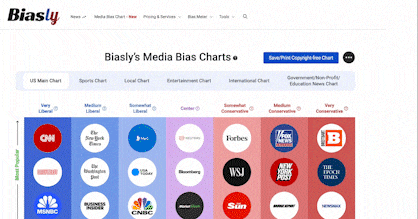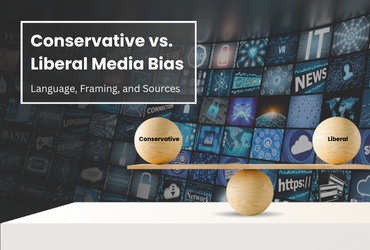
Much of what we understand about bias in media comes from visibly biased language, which includes negative words used to describe policies or politicians from the opposing side, and positive words used to describe policies and figures on the side that they support. They might use headlines that draw attention to the harmful effects of a bill passed, or use pictures with a negative view of the subject (i.e., an aggressive or angry face of an opposing politician).
Hypothetically, if a news source were to disagree with a protest, they would often label it as a ‘riot’ in the title and show something on fire as the main image. If a source were to disagree with a bill, it would highlight the negative impacts and cite sources that disagree with the bill.
However, many biased sources will try to hide their bias by refraining from using overtly biased language. Some sources might give leniency to a certain side, while not giving the same leniency to the opposing side. Other sources might focus on the voices of experts with certain qualifications that fit their narrative.
Ultimately, to best understand Conservative and Liberal media bias, one must approach it with an open, yet cautious mind. While there are people who intentionally include bias so that they may control the narrative, there are also plenty of people who unintentionally include bias and genuinely want to provide factual and honest reporting.
Because it is incredibly difficult to say a source is deliberately biased definitively, it is up to the reader to draw their own conclusions. At Biasly, we work to provide our analysis, but also to provide you with the resources necessary to draw your conclusions.
But, one may ask, how can you identify what is biased to which side? Sure, reading an article will give a few obvious signs through the title or specific vocabulary use. You can look at the sources used or read other articles published by the news source or author. However, you cannot fully understand how each side presents bias until you understand their ideology and what drives their actions.
Fundamentals of Liberal vs. Conservative Ideology
Liberals and Conservatives represent two different ideological sides. But to understand either ideology, you have to analyze popular topics and how each side stands on them. Therefore, we will analyze the debate on social issues, the role of government, and the voice of experts.
Social Issues
Among the pressing issues of the 21st century are societal issues regarding race and sexual identity. Much of the societal debate surrounds issues such as Diversity, Equity, and Inclusion (DEI) programs and LGBTQ+ equality. Analyzing stances on these issues allows us to understand the societal values held by either side. These societal values, in turn, can be turned into bias in the media.
Take, for example, DEI initiatives and how it is displayed in the media. DEI, also referred to as Affirmative Action, is a policy that organizations enact that allows them to take race, ethnicity, sexual orientation, or gender into consideration in hiring or admission processes. Liberals argue DEI gives opportunities to historically disadvantaged groups. According to a 2024 Pew Research poll, Democrat or Left-leaning workers tend to have a positive view of DEI in the workplace. Here, they differ with their Republican counterparts, who tend to have either a neutral or negative view of DEI in the workplace.
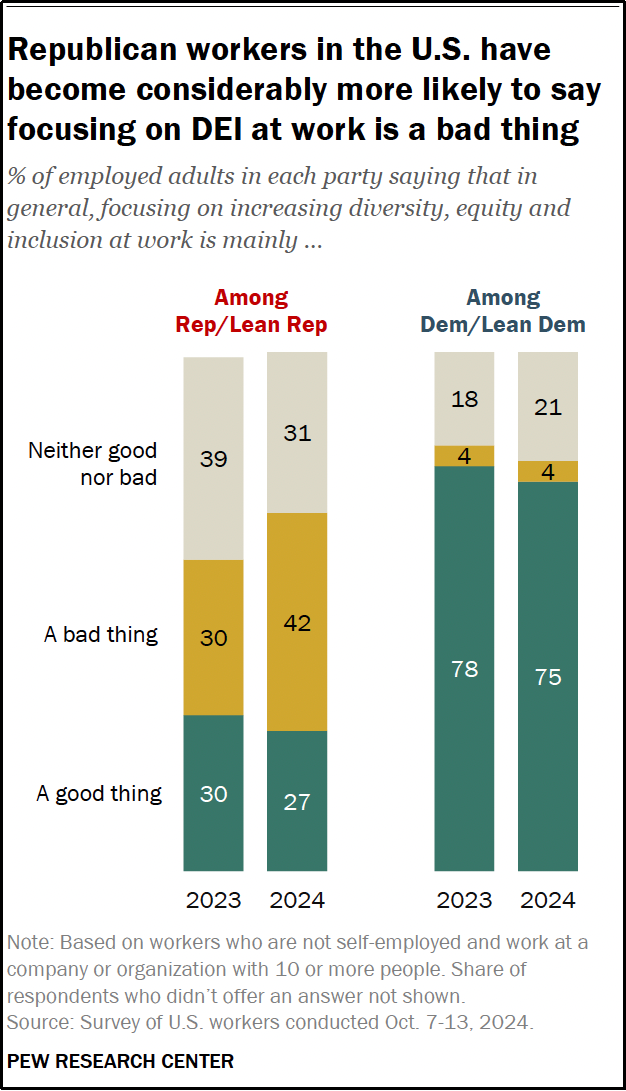
Source: Pew Research
These sentiments are often reflected in news media publications. CNN, which Biasly’s Media Bias Ratings rates as ‘Very Left’, published an article praising DEI, claiming that it has helped many historically marginalized groups. Notably, the article dates DEI programs back to the 1964 Civil Rights Act, which prohibited employment discrimination based on sexual identity, gender, race, and ethnicity.
There lies the fundamental perception of social issues among liberals. In the eyes of liberal or left-leaning individuals, the civil rights and equality movement never ended. They believe that DEI programs are a continuation of the Civil Rights Act, and that there still is more work to be done for true equality.
Comparatively, Conservative and right-leaning sources believe that the Civil Rights movement is something of the past. They believe equality has been obtained, and thus, the modern Civil Rights movement will only lead to more racism.
That idea can be seen in the previously mentioned CNN article, which quoted a post from Elon Musk, a notable conservative and former member of the second Trump administration, on X (formerly Twitter). Musk stated in the post that “DEI is just another word for racism”, supporting the Conservative belief that DEI and other modern equality movements are only propagating racism.
This is further supported by an article from FOX News, which is rated ‘Very Right’ by Biasly’s Bias Meter. The article follows a report on “woke” hospitals and healthcare organizations. It claims that DEI is just another way to discriminate against people based on race. To many Conservatives, there is no desire to repent for historic injustices. They believe people today are different from the people of the past, and thus, the people today should not be “punished.”
To summarize, Liberals and other left-leaning people believe that DEI is a continuation of the 1900s’ Civil Rights movement. They believe that DEI fights racism in employment and acceptance and attempts to correct historical wrongs. Conservatives and other right-leaning people believe that DEI is a modern attempt at racism, and that there is no connection between DEI and the 1900s’ Civil Rights movement.
Ultimately, Liberals believe that the fight for equality is still ongoing, while Conservatives believe that the fight for equality is long over.
Role of Government
Most debates in politics ultimately return to one question: What is the role of the government? In other words, should the government be more actively involved in the personal lives of its residents, or should it let everybody make their own decisions and stay uninvolved?
You can directly see this conflict in popular debates, such as Welfare, healthcare, and abortion. Looking at how each type of biased news source depicts these debates can help us understand each side’s ideology, therefore making it easier to spot biased articles in the future.
Let us focus on the debate over welfare, or, in other words, government assistance to qualifying people. Some may argue that monetarily assisting the poor does more harm than good. They believe that they are going to waste the money, and it isn’t the job of the taxpayers to bail the poor out. Others argue that assisting the poor does more good than harm. They believe many people fall upon hard times through no fault of their own, so it is morally and economically right to help them get back onto their feet.
But what do the statistics say about who supports what? Well, a Pew Research poll found that Democrats or left-leaning people are more likely to say that providing welfare does more good than harm. Republican or right-leaning people, however, are more likely to say that providing welfare does more harm than good.
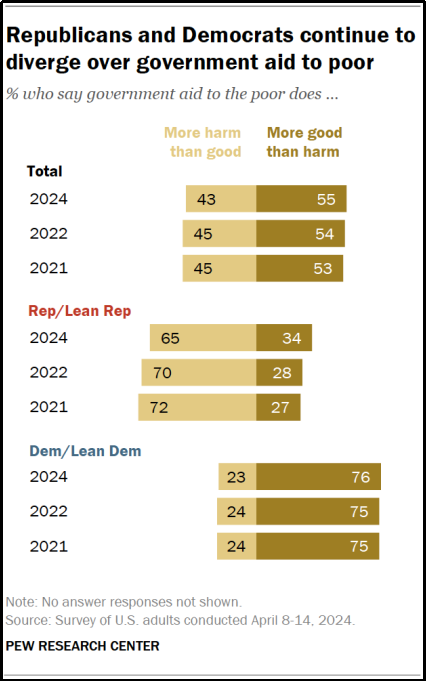
Source: Pew Research Center
A CNN article details the potential harmful effects of the “big, beautiful bill,” a controversial bill allocating funds and taxes. The article places an increased emphasis on the positives behind welfare and Medicaid. Much of the article appealed to empathy, stating that the potential blowback on people who need the assistance could be harmful.
Through this article, we can see the Liberals’ ideology on the role of government; it is their job and responsibility to help those in need. In the eyes of left-leaning news sources, any sort of damage done to those on Medicaid or welfare is unacceptable.
Contrastingly, the Conservatives’ views on these cuts focus on a completely different aspect. A FOX News article covering the same cuts from the “big, beautiful bill” provide a different focus. The article opted to focus on cutting those who do not deserve Medicaid.
According to the article, Liberals are misrepresenting the changes. The article says that the cuts will make it difficult for people to “scam” the Medicaid system. Here, many conservative news organizations appeal to the distrust of people, and that many people will abuse a system of generosity.
These articles demonstrate the key difference between the two ideologies. Liberals are more prone to having the government take a generous role. But Conservatives are far more likely to be suspicious of people trying to access welfare, and believe that the welfare system is corrupt.
Voices of Experts
In this section, understand that the word ‘expert’ will always be put in quotation marks. This is not to say that we are mocking them or that they are unqualified, but it is because this section explores different definitions of “expert.”
Perhaps the most popular way for News Sources to discredit an opposing view or justify their own is by quoting “experts” in relevant fields. But, “expert” has an inherently broad definition. This allows news sources to classify a person as an “expert,” even though some may not consider them such. Through these definitions of “experts”, news sources may provide unreliable and biased sources as a justification for their views.
Liberal and left-leaning people often provide a stricter definition of who is an “expert”. They will often rely on colleges or individuals with an M.A., Ph.D, or J.D. degree as “experts” in the field. Oftentimes, left-leaning individuals tend to have a more positive view of colleges and universities compared to their right-leaning counterparts, according to a Pew Research poll.
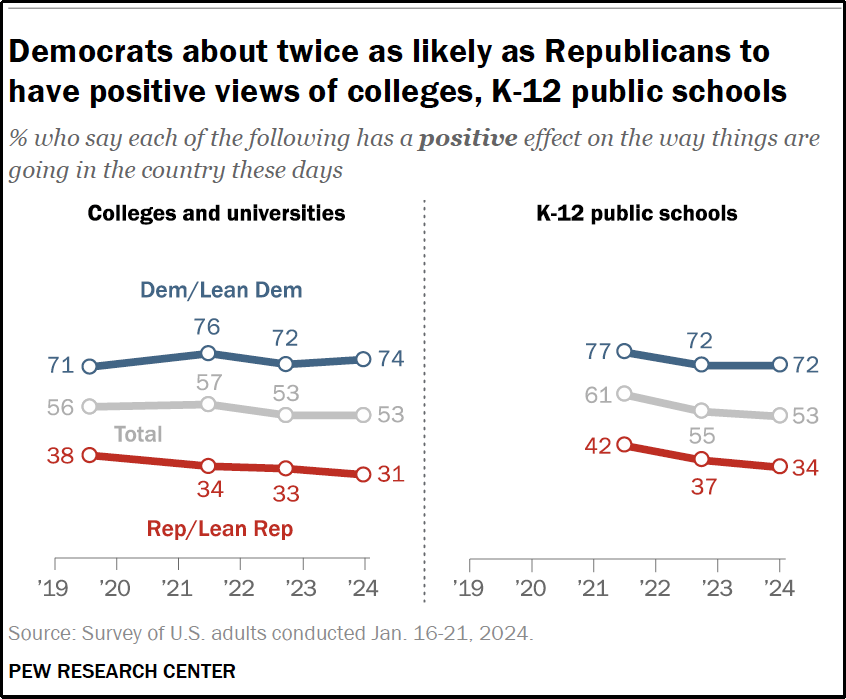
Source: Pew Research
Left-leaning sources often follow this trend, typically using colleges or other higher education institutions as their primary sources. CNN, which Biasly’s Media Bias Chart rates as ‘Very Left’, published an article detailing the potential impacts of Trump’s “big, beautiful bill.” The article cites the opinions of “experts” in this field, such as colleges and think tanks, such as Brookings.
Liberals tend to put increased trust in education and traditionally official sources. Thus, they have a stricter definition of an “expert”, opting to trust people with official credentials. These credentials might come in the form of a certificate for passing a course or a degree from a college. Ultimately, liberals are more likely to trust these sources.
Conservatives, however, put less of an emphasis on official qualifications. Most conservatives or right-leaning individuals do not trust education to be unbiased. Many believe that left-leaning people overwhelmingly dominate education and thus use it to push their agendas.
The sources used in this FOX News article reflect this distrust. The sources are primarily independent conservative think tanks unassociated with colleges or other official institutions. Notably, they cite Urban-Brookings Tax Policy Center, calling them ‘left-leaning’. Urban-Brookings was used as a source by the previously mentioned CNN article, which called Brookings unbiased.
There, we see the key difference in “experts.” Liberals put more inherent trust in education and research institutions associated in some way with colleges. Conservatives believe that these colleges and institutions are inherently biased by left-leaning professors and administrators, and thus cannot be trusted. So, they put their trust in independent organizations, which often also distrust colleges.
What to Consider
But what do these ideological differences truly mean? How can understanding these help identify bias in the future? Looking at the ideologies can help us understand the common emotions displayed by either side, who each side trusts, and what the pressing issues are.
For Liberal ideology, the emotions displayed can be briefly summarized as empathy and guilt. When you read an article you suspect to be left-leaning, try to look out for these emotions. Does the article display guilt for events of the past and a desire to “correct” those situations through actions done today? Does the article appeal to your sense of togetherness or pity for others? Does it put trust in official qualifications such as degrees or certificates?
Conservative ideology, however, relies on emotions such as caution and individuality. Many Conservative articles will ask for caution and suspicion of those who wish to harm others. So, when you are reading an article you suspect to be right-leaning, ask yourself some key questions: Does the article emphasize personal responsibility and oppose collective responsibility? Do they argue for caution in government regulations on private affairs? Do they place their trust in independent organizations?
Biasly offers amazing insights into bias. If you believe an article is biased, feel free to check our website, Biasly. However, we also ask you to draw your conclusions and train yourself to recognize the previously mentioned emotions, so that you are better prepared to recognize bias.


























